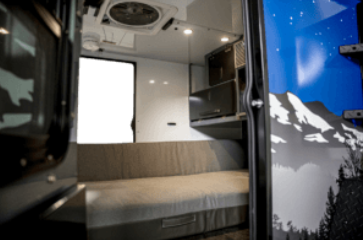How to manage moisture in your OGT trailer during use & during short/long term storage.
This article covers how to minimize and mitigate the accumulation of excess moisture in your OGT interior during storage and real world use across temperature ranges.

Interior Space
OGT trailers are designed to have a water tight interior space. This means that not only are you protected from the outside elements, but moisture generated inside has a difficult time escaping. In any type of RV, that moisture needs to be actively managed, otherwise you are going to end up with condensation issues.



The human body exhales approximately ½ a liter of water each day. If you are camping with a partner for a week in your OGT, even if you are only spending 8 hours per day in the trailer, your bodies are going to exhale approximately a combined 2.5 liters of moisture per week into the interior. How do you keep your OGT or RV from becoming a soggy swamp? Well the great news is that even if this ended up being the case you made the right decision in buying a zero wood trailer!
To help solve the moisture issue, every OGT utilizes a composite floor acting as a thermal break minimizing the transfer of heat/cool through the insulated floor structure. This minimizes the accumulation of moisture under the mattress. The mattress liner is also dual purpose and dual material. The top side cover is upholstered and the underside (floor facing) material is moisture resistant vinyl.
Even with these features, you still need to actively manage your moisture situation, particularly since our interior cabin is so water and air tight.
The first thing that you need to do is ensure there is ventilation. Always have a window and a roof vent open when the camper is occupied. The window doesn’t have to be fully open, just an inch or two. This will provide a way for the moisture to escape. Second, during colder months keep your temperature at 72°F or above with the heating system. The warmer temperature helps reduce condensation.
If for some reason you don’t follow the above steps for actively managing moisture before it occurs and you suddenly find that everything is damp, you will need to solve the problem. You are going to have to turn your heat well up above normal for an extended period of time with the fan operating at >50% fan speed in the "exhaust" direction to evacuate the moist air. Leaving the window open >1 inch will allow the air to be replaced and dehumidified. Remove the bed and all organic and fabric materials. Ideally it is best to remove all the contents of the trailer if the moisture was allowed to build to excessive levels.
The best thing is to keep the moisture from occurring in the first place and follow the previously mentioned steps.
All OGT trailers are built to last decades but to ensure they remain in top condition; you do need to ensure that they are properly used and maintained. Managing moisture will not only keep you dry and comfortable, it will prevent the occurrence of mold and damage to any additional accessories and items left in the trailer. In the event of short and long term storage, you may want to invest in desiccant products to ensure moisture is kept to a minimum over longer term periods.
Cargo Space - Tongue Box
The front cargo space are not insulated and therefore susceptible to condensation build up if there is a temperature/humidity change. Adequate ventilation is crucial for controlling condensation and when a trailer is in storage for a long time, air is not able to circulate freely. Without use the compartments remain closed for long periods of time and this combined with a change in atmospheric condition it can cause condensation on the inside. Ensure that there is proper airflow within the compartment by periodically opening and airing out the space. This allows moist air to escape, reducing the chances of condensation.
Happy camping!
![OGT logo-2.png]](https://support.offgridtrailers.com/hs-fs/hubfs/OGT%20logo-2.png?height=50&name=OGT%20logo-2.png)